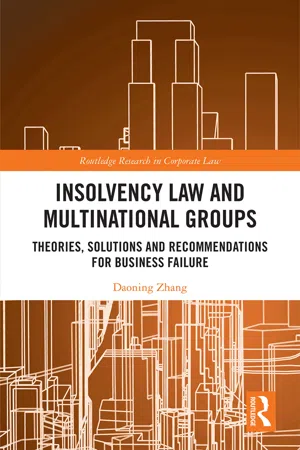
Insolvency Law and Multinational Groups
Theories, Solutions and Recommendations for Business Failure
- 234 pages
- English
- ePUB (mobile friendly)
- Available on iOS & Android
Insolvency Law and Multinational Groups
Theories, Solutions and Recommendations for Business Failure
About this book
The insolvency of multinational corporate groups creates a compelling challenge to the commercial world.
As many medium and large-sized companies are multinational companies with operations in different countries, it is important to provide appropriate solutions for the insolvency of these key market players. This book provides a comprehensive overview of the cross-border insolvency theories, practical solutions and regulatory solutions for the insolvency of multinational corporate groups. Whilst the book recognises certain merits of these solutions, it also reveals the limitations and uncertainty caused by them. An analysis of the provisions and tools relating to cross-border insolvency of multinational corporate groups in the new EU Regulation on insolvency proceedings 2015, the UNCITRAL Model Law on cross-border insolvency, the Directive on preventive restructuring frameworks and the Bank Recovery and Resolution Directive 2014, along with a study of directors' duties, are included in this book. This book focuses on the insolvency and rescue of non-financial corporate groups. However, it is also important to recognise the similarities and differences between corporate insolvency regimes and bank resolution regimes. In particular, lessons learnt from bank resolution practices may be useful for non-financial corporate groups.
This book aims to provide an in-depth examination of the existing solutions for the insolvency of multinational corporate groups. It also aims to view cross-border insolvency of corporate groups within a broad context where all relevant regimes and theories interact with each other. Therefore, directors' duties in the vicinity of insolvency, preventive insolvency proceedings, procedural consolidation, international cooperative frameworks and bank resolution regimes are considered together. This book may appeal to academics, students and practitioners within the areas of corporate law, cross-border insolvency law and financial law.
Frequently asked questions
- Essential is ideal for learners and professionals who enjoy exploring a wide range of subjects. Access the Essential Library with 800,000+ trusted titles and best-sellers across business, personal growth, and the humanities. Includes unlimited reading time and Standard Read Aloud voice.
- Complete: Perfect for advanced learners and researchers needing full, unrestricted access. Unlock 1.4M+ books across hundreds of subjects, including academic and specialized titles. The Complete Plan also includes advanced features like Premium Read Aloud and Research Assistant.
Please note we cannot support devices running on iOS 13 and Android 7 or earlier. Learn more about using the app.
Information
1 Introduction
Background and the value of this study
Issues and difficulties of MCG insolvency and resolution
Table of contents
- Cover
- Half Title
- Series Page
- Title Page
- Copyright Page
- Dedication Page
- Table of Contents
- List of abbreviations
- Table of cases
- Table of legislation
- Abstract
- Acknowledgement
- 1 Introduction
- 2 Theoretical basis of corporate rescue and implications on rescue of multinational groups of companies
- 3 Cross-border insolvency theories and procedural consolidation
- 4 Market/hybrid approaches to cross-border insolvency of MCGs in the EU
- 5 Group coordination and planning proceedings
- 6 Directors’ duties of corporate groups
- 7 Lessons from financial institution resolutions
- 8 A way forward
- Bibliography
- Index